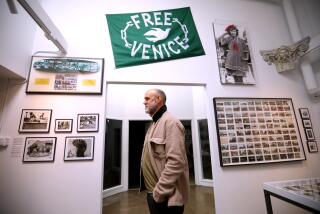The ancient Roman city of Altinum rises from Venice Lagoon
- Share via
Aerial photographs taken during a drought two years ago have enabled Italian researchers to produce the most detailed map ever of the ancient Roman city of Altinum, considered by some historians to be the ancestor of modern-day Venice.
The dryness of the landscape enabled the team from the University of Padua to see evidence of 2,000-year-old structures beneath the soil -- including remnants of churches, city walls, gates and even a theater, according to the research published in this week’s edition of the journal Science.
Like Venice, Altinum sat in the large lagoon connected to the Adriatic Sea that is now known as the Venice Lagoon. At around 200 square miles, it is one of the largest bodies of water of its kind in the world. Larger than Pompeii, Altinum was among the most influential cities in northern Italy during Roman times and home to as many as 20,000 people, according to Alessandro Fontana, one of the researchers who produced the map.
In the 1st century BC, “Altinum was a quite important harbor,” said Fontana, a professor in the university’s geography department. “Archaeologists consider it to be like a maritime emporium where traders arrived from all around the Mediterranean.”
Altinum had also been famous since the Iron Age for wool production and horse breeding, Fontana said.
Creating this new map of one of the Roman Empire’s great cities was possible because Altinum, unlike most ancient cities in Europe, was not built over by later generations. As a result, the researchers were able to use aerial photographs to peer beneath the modern farmland covering the ancient city to reveal subsurface stones, bricks and compacted soil. The severe drought of 2007, which dried up vegetation in the area, also made it easier for the visible-light and near-infrared cameras to reveal the structure of the city.
Today, about 11% of the lagoon is permanently covered by open water, and around 80% consists of mud flats, tidal shallows and salt marshes.
As with Venice, life in Altinum was dominated by water.
Residents willingly accepted the curse of mosquitoes and other insects in exchange for the relative safety of life protected from land invaders, according to Fontana. The resources of the lagoon itself -- fish, game and salt -- would have been an additional inducement to settlers, Fontana said, along with a direct route to the Adriatic.
Altinum’s eventual destruction was signaled by the arrival of Barbarian invaders in the 5th century AD. The inhabitants began fleeing deeper into the lagoon, eventually settling in what later became Venice. The local bishop held on until as late as the 7th century, before moving to Venice, Fontana said.
The memory of Altinum is preserved today in the names of several Venetian islands -- Torcello, Burano, and Murano -- which were named for districts in the old city.
Not only is the spirit of Altinum preserved in modern Venice, its roots are in the foundation of Venice itself, Fontana said. Much of the early stone and brick-work used to build the churches and palaces in Venice was carted in from Altinum.
Geoffrey Symcox, a professor emeritus of European history at UCLA, said the Italian team’s work will likely revise history’s opinion of Altinum’s role in Roman affairs. “Its main claim until now was that it was sacked by Attila and the Huns,” he said.
After looking at the new map, he added: “I think they’re onto something. There’s a very good case to be made that this was a place people fled to Venice to get away from the Huns.”
It’s ironic, he said, that “a climatic accident” made the discovery possible.
Fontana said he and co-workers Paolo Mozzi and Andrea Ninfo have received funding for a much more ambitious research project at Altinum that could include opening the site to tourists. Archaeological digs to unearth buried structures are also possible, he said.
--




